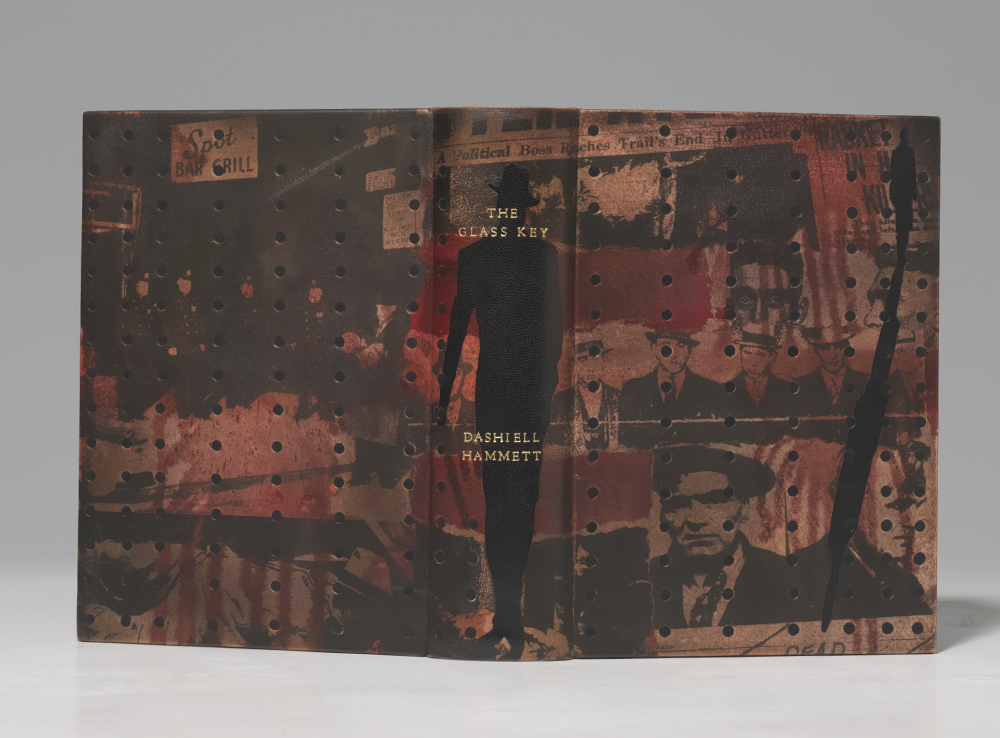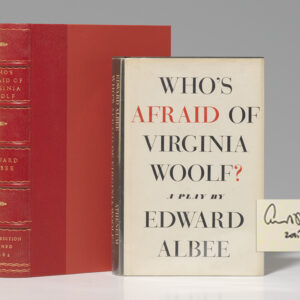Description
“TO LILLIAN FOR MY BIRTHDAY—DASHIELL HAMMETT, HOLLYWOOD, MAY 27-1931”: EXCEEDINGLY RARE PRESENTATION/ASSOCIATION FIRST AMERICAN EDITION OF HAMMETT’S “LAST GREAT NOVEL,” THE GLASS KEY, WITTILY INSCRIBED BY HIM—ON HIS BIRTHDAY—AS A GIFT TO PLAYWRIGHT LILLIAN HELLMAN WITHIN MONTHS OF THEIR FIRST PASSIONATE ENCOUNTER IN HOLLYWOOD AND A MONTH AFTER PUBLICATION, THE BEGINNING OF A LOVE STORY AT THE CORE OF 20TH-CENTURY AMERICAN LITERATURE
HAMMETT, Dashiell. The Glass Key. New York, London: Alfred A. Knopf, 1931. Octavo, original green cloth, original dust jacket. Housed in a custom clamshell box.
First American edition of Hammett’s “last great novel,” an exceedingly rare presentation/association copy wonderfully inscribed by Hammett—on his birthday—to his lover, playwright Lillian Hellman, “To Lillian for my birthday—Dashiell Hammett, Hollywood, May 27, 1931,” one of the few known inscribed copies ever offered, dated by him barely five months after first meeting Hellman at a Hollywood party and one month after the book’s publication, signaling the beginning of a turbulent love affair of over 30 years, electrified by “something unspoken but profound… What drew them to each other at first was that both were willing to live without restraints, to see what would happen” (Mellen), in rarely found unrestored original dust jacket, handsomely housed in a custom half morocco clamshell box.
This rare presentation first American edition of The Glass Key, Hammett’s “last great novel,” possesses an exceptional association—for this copy is wonderfully inscribed by him to famed playwright Lillian Hellman, his lover and frequent writing partner for over three stormy decades (Mellen, 27). In the history of 20th-century American literature, their love story defined the time as much as it defined them. “One of the great 20th-century American literary icons, Hammett invented the hard-boiled detective novel” and Hellman, author of award-winning dramas such as The Children’s Hour (1934) and Watch on the Rhine (1941), is “one of the most important playwrights of the American theatre” (New York Times). They first met at a Hollywood party on November 22, 1930, only months before publication of The Glass Key. Hellman was with Darryl Zanuck and Lee Gershwin when “a lean handsome bone-thin man over six feet tall, with a surprising shock of white hair framing an angular face and muddy-brown eyes, passed their table… ‘Who’s that man?’ Lillian demanded at once… Lillian went right up to the tall, handsome, white-haired man… A shock of mutual recognition passed between them. They soon repaired to the parking lot to be alone in the back seat of her car” (Mellen, 38-39). “The effect they had on each other was remarkable. Though they were lovers, neither was ever faithful. Yet when they were together they were a formidable team.” When Hellman’s play, The Children’s Hour, opened in 1934, only four years after that electrifying first encounter, “she was an overnight sensation… and by the year’s close, Hellman was a name that could be uttered in literary circles in the same breath as Hammett” (Layman & Rivett, Selected Letters, 59). Throughout their tempestuous relationship, there remained “something unspoken but profound… What drew them to each other at first was that both were willing to live without restraints, to see what would happen” (Mellen, 39).
Hellman never stopped thinking of Hammett as “the single individual who could not be corrupted, blackmailed, bribed,” and Hammett teasingly called her Lilishka, Lily, or sister, “the way a 20s gangster addressed his moll.” This rare copy of The Glass Key, humorously inscribed by Hammett to Hellman—on his birthday within months of that first meeting—marks the first of many they celebrated together. When she once missed his birthday he joked, “‘You say you love me, but you haven’t yet given me the birthday present due last May.’ What he wanted from her was ‘to have some very nice little thing to hold on to.’ Only Lily truly understood him… What he wanted was a symbol of their bond” (Mellen, 463, 198, 206). Their passion and literary brilliance was the focus of several biographies, as well as the 1977 film, Julia, starring Jane Fonda as Hellman and Jason Robards in his Oscar-winning performance as Hammett. Targeted by McCarthyism, when both were blacklisted and called before the House on Un-American Activities, Hammett was imprisoned for refusing to testify and Hellman famously wrote: “I cannot and will not cut my conscience to fit this year’s fashions. At the age of 66, weakened by long illness, Hammett died in January 1961. Hellman died in June 1984. “While best known for The Maltese Falcon, Hammett believed that The Glass Key was his finest achievement. The book was first published in England in 1931 by Knopf, which closed their London office soon after” (Fine Books & Collections). This first American edition quickly followed three months later. The novel features Ned Beaumont, one of the toughest of Hammett’s heroes. The New York Times described it as combining “the tradition of Sherlock Holmes with the style of Ernest Hemingway.” Serialized in the magazine Black Mask in four parts from March through June 1930, Hammett revised The Glass Key extensively for book publication. Layman A4.2.a.
Text fresh and clean, slight toning to cloth; slight edge-wear to very scarce unrestored dust jacket. An extraordinary presentation copy of an American classic, with an exceptionally rare association.




